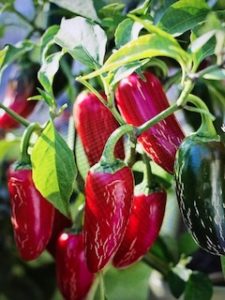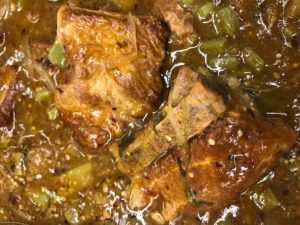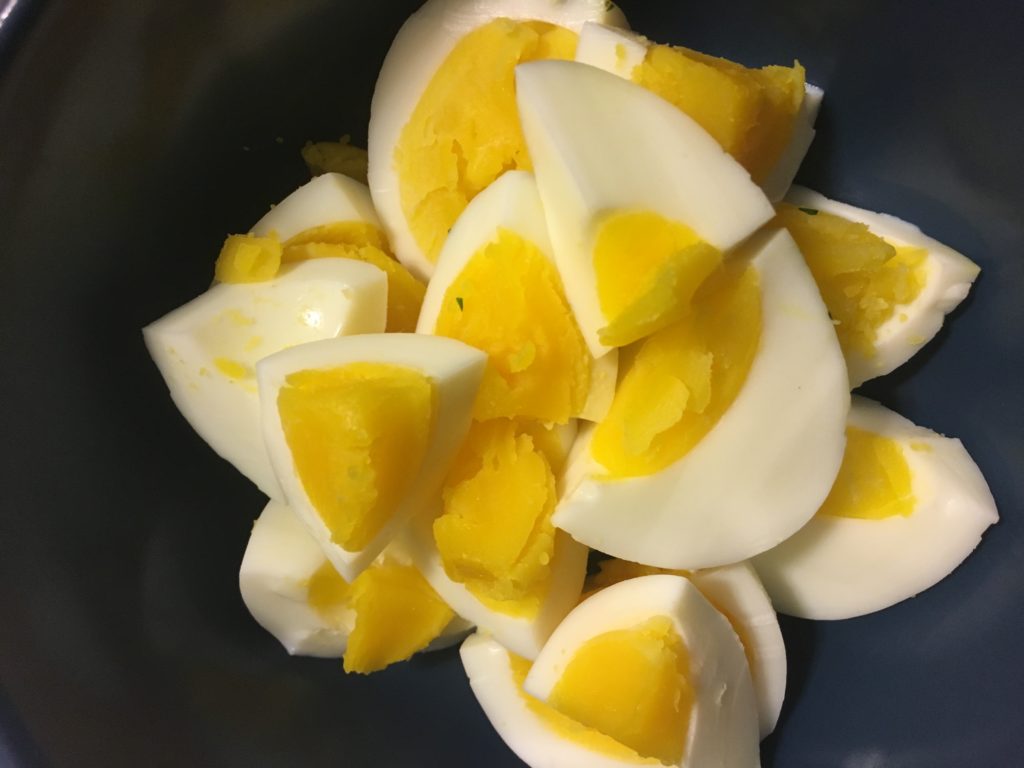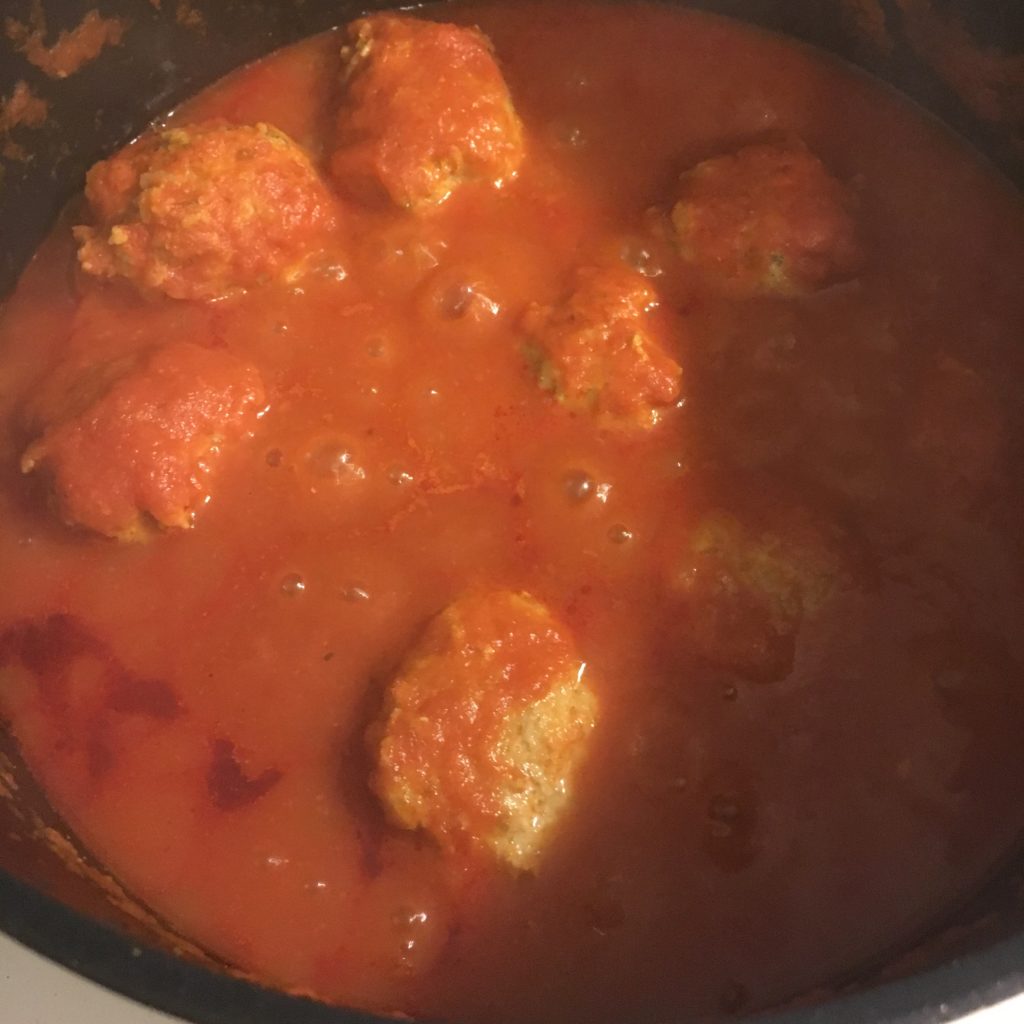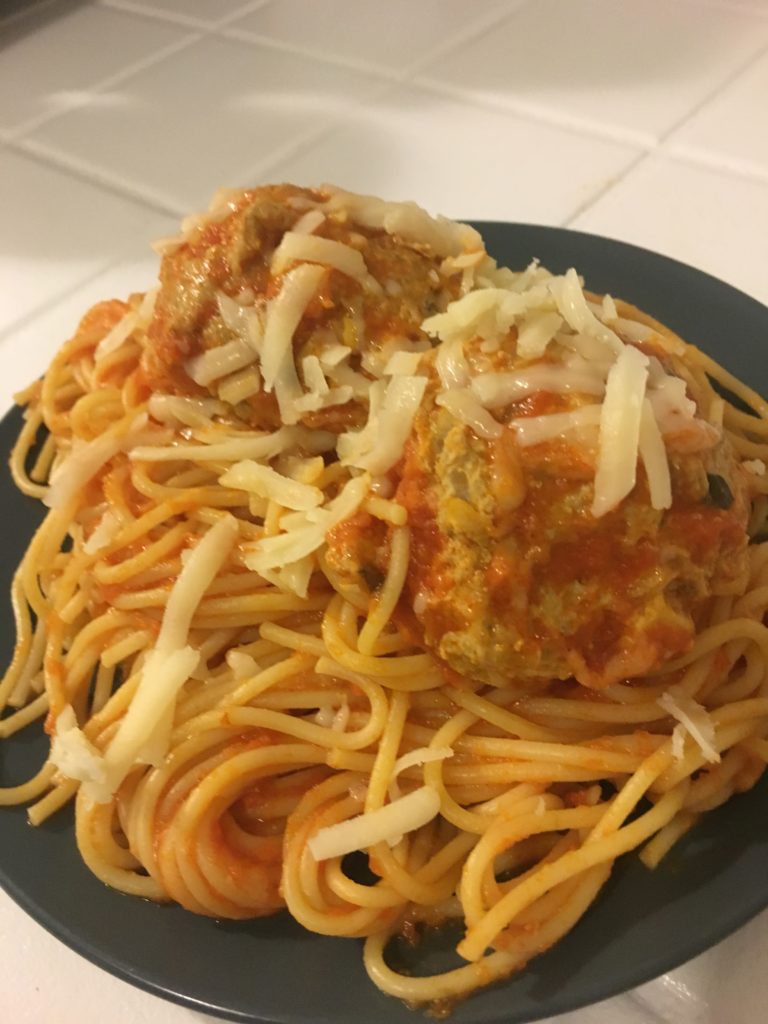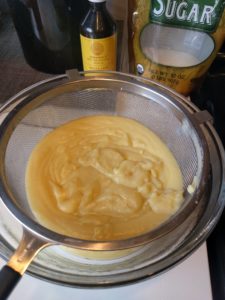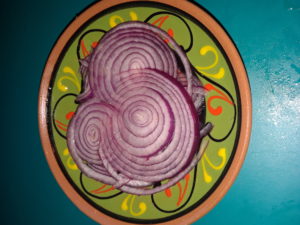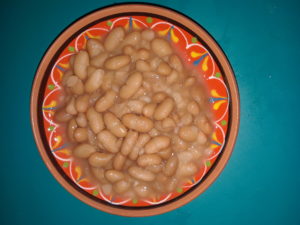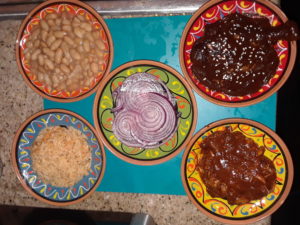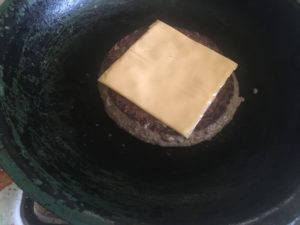Food is a big deal in my family. I am Mexican American and having both parents born and raised in Mexico meant I would grow up eating mostly Mexican food. From breakfast to dinner, except while I was in school, I only ate Mexican food. I guess it did not help that my parents did not have a lot of money, so we could not really go out and try other new things, unless it was something inexpensive. On the few occasions that my dad got to work some overtime, we got to eat a little different the following weekend. He would take us to have pizza from Nino’s Pizza in Lynwood (which is no longer in business), Cousimano’s Pizza in South Gate, or sandwiches at the beach. Otherwise, if he received a regular check, we would stay home and have rice and beans as usual. I was tired of eating the same meals so often but there was no money for more. Some time in my teen years I was introduced to real Italian food and from that point on, I fell in love with it. I have tried almost every Italian dish there is out there.
I was in my church youth group when a friend of mine, who was older and already working, said she wanted to take me out for my birthday. She said we were going to eat real Italian food; I had no clue what she meant by “real” because I have eaten pizza and spaghetti before and I love to eat pizza. Either way, I agreed to go wherever she chose to take me and my younger sister. I cannot remember the name of the place she took me to, but it was cute, small, the whole restaurant theme was of course from Italy, and the servers were very polite.
My friend ordered for us. She ordered me the meat lasagna plate. While the meals were cooking, we were served bread with bruschetta. I liked it so much I had to ask for more. But the moment of truth was when I got my order. It looked mouthwatering and smelled delightful. When that first spoonful of lasagna hit my taste buds, it was like a piece of heaven. I did not stop eating until I ate it to the last bit. I savored every bite like it was the first one.
From that point on, my friend would occasionally take me back to try other dishes, or she would take me to other restaurants to taste the difference in spices and that included the pizza. I was eating Italian food like there was no tomorrow, but my dream was short lived as my friend eventually said we need to stop as it was getting expensive. Since she would no longer take me out to eat, I begged my mom to take me. She would tell me it is too expensive for nine of us even if she was working then. But to please me, she said she would try to make the meals herself instead. My mom bought magazines, recipe books and started making Italian meals. The first dish I asked her to make was lasagna. I cannot deny it was very good, but there was no comparison to the restaurants. She continued on to making other Italian dishes and since I was liking them all, she promised to make it a tradition and prepare two Italian meals a month. Mexican food was cheaper to make and since there was so many of us, it was more cost effective to cook what she grew up with and already knew how to cook. Italian became my favorite type of food. Come to think of it, I guess the sauce (whether it be creamy, garlicky, or tangy) is what attracts me about the food, because I savor the sauce every time I taste it.
When I was old enough to make my own money, I tried making new dishes for my family. When I became a mom, I enjoyed making new meals even more because I now had my own babies to cook for and Italian was always top pick. My mom may have started the tradition to make Italian food twice a month, but I made sure to make the meals more often. I also think about my friend when I make these meals.
A dish I made a while ago was the chicken Florentine gnocchi with polenta. The sweet and tangy flavors I tasted with the mix of the chicken, sun dried tomatoes, and the creamy sauce were just finger licking good or at least I thought so. However, once my kids tried it, liked it and my fiancée also gave me a thumbs up, I made it a couple more times. I felt that since I got good reviews from my family, I would then choose to make this dish again and share it with my class because it not only looks good, it tastes good. I got the recipe online, but I doctored it up a little to enhance the flavors.
The word Florentine comes from Florence, Italy (Elliot, n.d.). The title Florentine makes the dish sound sophisticated, yet all it means is that there is spinach in the dish. Any dish that has spinach added can be categorized as a Florentine dish (Elliot, n.d.). Though there are other herbs that can qualify dishes to be considered Florentine, spinach still tops the meaning of Florentine (Elliot). Queen Catherine de Medici from Florence introduced spinach in the meals in the mid-1600s. She declared it Florentine which is why spinach is more familiar and popular to the title (Elliot, n.d.).
Jo Lewin reports, eating spinach has been known and promoted to give good health. As it was shown on the cartoon, Popeye, any time he was bullied he just had to open a can of spinach, eat it, and his problems were solved. Upon eating the spinach, he would become a superman. He was very strong and look very healthy. Spinach does have well over a dozen reasons why anyone should often eat it to stay healthy and avoid certain illnesses.
The next main ingredient is the gnocchi. Gnocchi goes back to the renaissance days where it was a widely known pasta (Saveur, 2015). It is a pasta made from a few ingredients as well as potatoes. I say a few ingredients because depending where it was made, the ingredients would change, and so would the name, such as zanzarelli and malfatti (Saveur, 2015).
Sun dried tomatoes are basically tomatoes treated with sulfur dioxide and set in the sun for about 4-10 days to dry (en.wikipedia.org). Once they are dried out, they are either packaged or pickled in olive oil and other herbs. That is what gives the tangy flavor to the pasta.
Polenta was well known as food for the poor or peasant food. It was primarily eaten in northern Italy. Bread was available and reachable to any family but they all preferred to eat polenta because of its yummy flavor and it was a replacement of the bread (Demetri, n.d.). A family’s status did not matter because rich or poor, polenta was eaten everywhere. It was made of grains and served like a cream of wheat dish or it could be served as a side dish.
Back in the Roman days, polenta was also quite popular, but they use to call it pulmentum (Demetri, n.d.). It could stay just with the poor families as the taste was quite popular and craved all over Italy even if it lost some popularity when an ingredient was changed to “maize” (Demetri, n.d.). I have never had it like a porridge, only as a loaf and pan fried.
-1 package of Gnocchi (the one made from potatoes is recommended for this dish)
-1 cup fresh spinach (if you really like spinach, you can double the measurement)
-1 cup sun dried tomatoes (the ones that are conserved in oil would be best to use so you can pour in a few drops of that oil while they are boiling, for additional flavor)
-2 boneless skinless chicken breasts
-1/4 cup butter (you will need a little extra for the polenta)
-1 cup heavy cream
-1 Tbs. chopped garlic (but if you love garlic, you can double the required measurement)
-1 1/2 cups grated Parmesan cheese (if you like cheesy Italian food, you can double this ingredient too)
-A roll of polenta
Preparing the pasta:
1) The chicken is sliced into strips (how big you want the strips is your choice).
2) The strips are sautéed in a pan on high until the strips are browned all around. I sauté them with butter to kill the strong chicken flavor. 
3) While the chicken strips are cooking, I put a pot of water to boil in a medium size pot. I fill the water about half way (fill almost to the top if you double the serving). When the water is at its boiling point, add in the gnocchi and sun dried tomatoes. Allow the gnocchi to cook between five to eight minutes. You can poke it with a fork, in case it needs a little more time, and ensure the gnocchi cooks thoroughly to avoid it getting soggy. 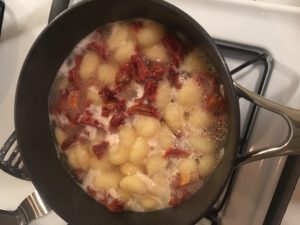
4) the spinach is supposed to be steamed but if you do not have a steamer, cut the leaves in half and put them in a little pan with a little water and cook them until they are shriveled up. Set them aside for later.
5) In a small pan melt the butter (if you cut the butter stick in small pieces, it will melt faster) and once melted, add in the garlic for about two minutes (or when you see that the garlic has browned).
6) When the butter and the garlic are well mixed, pour in the heavy cream. It is not supposed to boil, but make sure you constantly stir it until it is nicely blended.
7) Once step five is done, the parmesan cheese is added to the cream sauce at this point. Make sure to stir often and up to about 10 minutes. The mix will have a semi thick consistency.
8) Lastly, once the cream sauce done then mix it with the spinach, the gnocchi and the chicken. When the ingredients all mix together and while it is still warm, it is ready to be served.
Preparing the polenta:
The polenta comes in a roll, like sausage does. It does not require much to prepare. You just need to cut a couple thick slices or as many as each person desires and grill the slices with some butter until they are golden brown on each side.
I like to top the pasta with a little more Parmesan and some crushed pepper flakes. I accompany the pasta with either polenta, a salad, or with a role, but in this case, I chose the polenta. I neatly stack the slices beside the pasta and voila, it is ready to eat. It may not be the healthiest, but it is very yummy. To complete the whole Italian experience, I like to add a nice glass of red wine when I eat this pasta dish. My kids have their meal with cranberry juice in a wine glass, this way they feel they are drinking fancy also. I do no often get to eat with my kids as a family but when I do, homemade meals are the best to serve. 
References
-Elliot, S. (n.d.). What Does Florentine Mean in Cooking. Retrieved March 05, 2018, from http://cooking.lovetoknow.com/what-does-florentine-mean-cooking
–Pasta’s Predecessor: The History of Gnocchi. (n.d.). Retrieved March 02, 2018, from https://www.saveur.com/article/food/history-of-gnocchi
–Polenta. (n.d.). Retrieved March 02, 2018, from https://www.lifeinitaly.com/food/polenta.asp
–Sun-dried tomato. (2018, March 03). Retrieved March 05, 2018, from https://en.wikipedia.org/wiki/Sun-dried_tomato
–The health benefits of spinach. (n.d.). Retrieved March 08, 2018, from https://www.bbcgoodfood.com/howto/guide/ingredient-focus-spinach



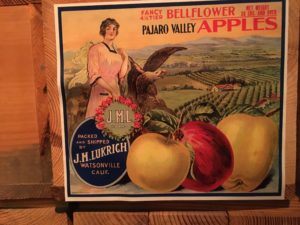




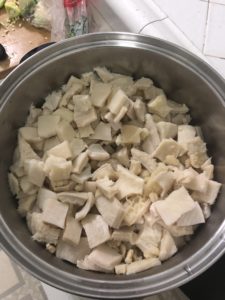
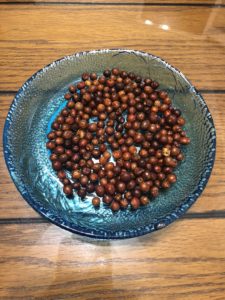

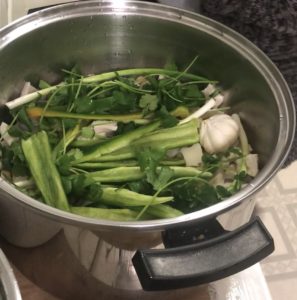


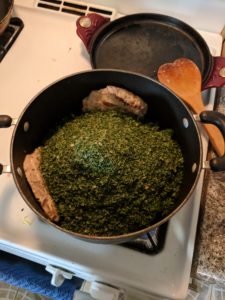 k the dry herbs 10 minutes prior to adding to the stew. Boil water separately while cooking the meat and onions. Drain the dry herbs and add them to the partially cooked chicken along with the other greens. The dish is traditionally
k the dry herbs 10 minutes prior to adding to the stew. Boil water separately while cooking the meat and onions. Drain the dry herbs and add them to the partially cooked chicken along with the other greens. The dish is traditionally 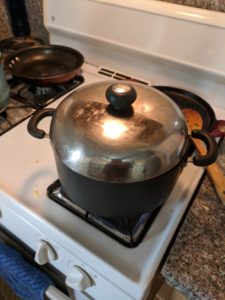 made with dried lemons or lemon juice, but I forego that step because I do not like the dish to be sour, rather I prefer it on the salty side. Once the water boils in a separate pot, add it to the pot. Once most of the ingredients are in the pot, keep it on high heat until it reaches a rolling boil and stir continuously. Lower the heat to medium-low and keep the lid on the pot tilted until enough water evaporates to get to a stew-like consistency. Stir about every 8 minutes to make sure the herbs do not stick to the bottom or sides. Cooks in about 45-60 minutes depending on the amount of water added. Wash rice three times and add enough water for the level to be up to the second line of your index finger above the rice. Cook on high heat until a rolling boil is achieved. Add salt. Leave it on medium-low until water evaporates.
made with dried lemons or lemon juice, but I forego that step because I do not like the dish to be sour, rather I prefer it on the salty side. Once the water boils in a separate pot, add it to the pot. Once most of the ingredients are in the pot, keep it on high heat until it reaches a rolling boil and stir continuously. Lower the heat to medium-low and keep the lid on the pot tilted until enough water evaporates to get to a stew-like consistency. Stir about every 8 minutes to make sure the herbs do not stick to the bottom or sides. Cooks in about 45-60 minutes depending on the amount of water added. Wash rice three times and add enough water for the level to be up to the second line of your index finger above the rice. Cook on high heat until a rolling boil is achieved. Add salt. Leave it on medium-low until water evaporates.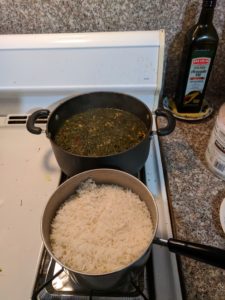
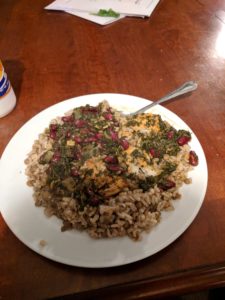 Take a generous portion of rice and pour Ghormeh Sabzi all over the rice. Salt to taste. Enjoy with yogurt or by itself.
Take a generous portion of rice and pour Ghormeh Sabzi all over the rice. Salt to taste. Enjoy with yogurt or by itself.


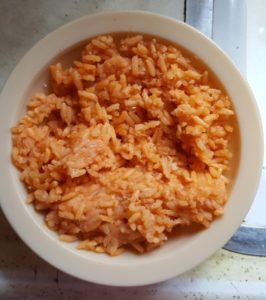 The main course, (Note: A good idea would be to ask the butcher to cut your ribs about two inches wide.) Place a large pot with one tablespoon of vegetable oil and begin simmering the pork ribs. The reason why very little oil is used is because pork many times releases its own oil. This is also the reason we don’t add salt to the ribs themselves because pork can sometimes be very salty. Place ribs in the large pot, and make sure the oil is very hot before the ribs go in. Fry over a high flame until crispy on the outside, which will ensure a tender juicy center. Fry up all the meat quickly so the inside doesn’t dry out. In a different pot add water deep enough to fit in about 25 jalapeños and two large roman tomatoes. I enjoy roman tomatoes better because I notice they are tastier than other tomatoes. Bring them to a boil and after ten minutes place half of the jalapeños and one roman tomato in the blender. You’re welcome to use more roman tomatoes to lessen the spicy taste. Once you have placed them in the blender add one tablespoon of salt and fill halfway with the same water they were boiled in. Next, follow the same instructions for the next batch of jalapeños.
The main course, (Note: A good idea would be to ask the butcher to cut your ribs about two inches wide.) Place a large pot with one tablespoon of vegetable oil and begin simmering the pork ribs. The reason why very little oil is used is because pork many times releases its own oil. This is also the reason we don’t add salt to the ribs themselves because pork can sometimes be very salty. Place ribs in the large pot, and make sure the oil is very hot before the ribs go in. Fry over a high flame until crispy on the outside, which will ensure a tender juicy center. Fry up all the meat quickly so the inside doesn’t dry out. In a different pot add water deep enough to fit in about 25 jalapeños and two large roman tomatoes. I enjoy roman tomatoes better because I notice they are tastier than other tomatoes. Bring them to a boil and after ten minutes place half of the jalapeños and one roman tomato in the blender. You’re welcome to use more roman tomatoes to lessen the spicy taste. Once you have placed them in the blender add one tablespoon of salt and fill halfway with the same water they were boiled in. Next, follow the same instructions for the next batch of jalapeños.